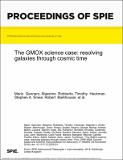The GMOX science case: resolving galaxies through cosmic time
Author(s)
Gennaro, Mario; Robberto, Massimo; Heckman, Timothy; Smee, Stephen A.; Barkhouser, Robert; Ninkov, Zoran; Adamo, Angela; Becker, George; Bellini, Andrea; Bianchi, Luciana; Bik, Arjan; Calamida, Annalisa; Calzetti, Daniela; De Rosa, Gisella; Deustua, Susana; Kalirai, Jason; Lotz, Jennifer; MacKenty, John; Manara, Carlo Felice; Meixner, Margaret; Pacifici, Camilla; Sabbi, Elena; Sahu, Kailash; Tumlinson, Jason; Bordoloi, Rongmon; ... Show more Show less
Download990849.pdf (2.067Mb)
PUBLISHER_POLICY
Publisher Policy
Article is made available in accordance with the publisher's policy and may be subject to US copyright law. Please refer to the publisher's site for terms of use.
Terms of use
Metadata
Show full item recordAbstract
We present the key scientific questions that can be addressed by GMOX, a Multi-Object Spectrograph selected for feasibility study as a 4th generation instrument for the Gemini telescopes. Using commercial digital micro-mirror devices (DMDs) as slit selection mechanisms, GMOX can observe hundreds of sources at R∼5000 between the U and K band simultaneously. Exploiting the narrow PSF delivered by the Gemini South GeMS MCAO module, GMOX can synthesize slits as small as 40mas reaching extremely faint magnitude limits, and thus enabling a plethora of applications and innovative science. Our main scientific driver in developing GMOX has been Resolving galaxies through cosmic time: GMOX 40mas slit (at GeMS) corresponds to 300 pc at z ∼ 1:5, where the angular diameter distance reaches its maximum, and therefore to even smaller linear scales at any other redshift. This means that GMOX can take spectra of regions smaller than 300 pc in the whole observable Universe, allowing to probe the growth and evolution of galaxies with unprecedented detail. GMOXs multi-object capability and high angular resolution enable efficient studies of crowded fields, such as globular clusters, the Milky Way bulge, the Magellanic Clouds, Local Group galaxies and galaxy clusters. The wide-band simultaneous coverage and the very fast slit configuration mechanisms also make GMOX ideal for follow-up of LSST transients.
Date issued
2016-06Department
MIT Kavli Institute for Astrophysics and Space ResearchJournal
Proceedings Volume 9908, Ground-based and Airborne Instrumentation for Astronomy VI;
Publisher
SPIE
Citation
Gennaro, Mario, et al. "The GMOX Science Case: Resolving Galaxies through Cosmic Time." Proceedings Volume 9908, Ground-based and Airborne Instrumentation for Astronomy VI, 25 June - 1 July, 2016, Edinburgh, United Kingdom, edited by Christopher J. Evans et al., 2016, SPIE, p. 990849. © 2016 SPIE
Version: Final published version